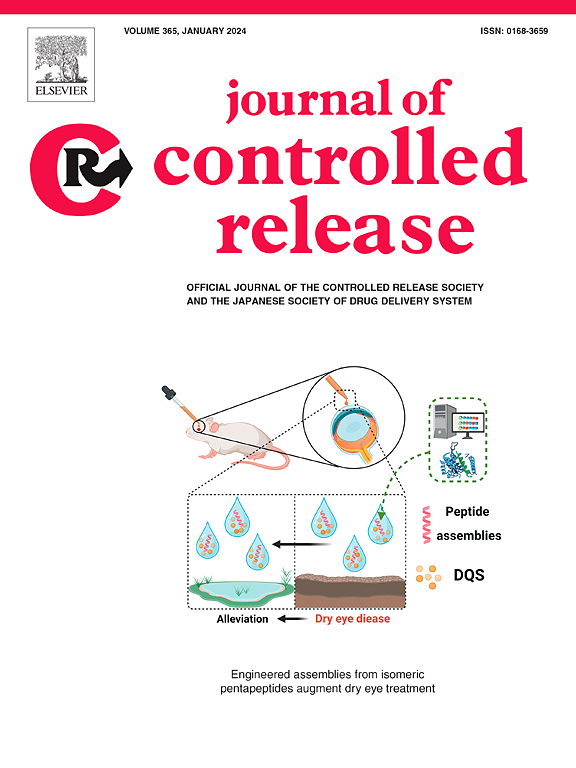通过多孔光固化水凝胶局部递送培养的角膜缘干细胞:一种无创、方便、高效的角膜缘干细胞缺乏干细胞递送策略
IF 10.5
1区 医学
Q1 CHEMISTRY, MULTIDISCIPLINARY
引用次数: 0
摘要
局部施用干细胞是治疗角膜缘干细胞缺乏症(LSCD)最简单的方法之一。如果不及时补充有缺陷的干细胞,LSCD可能会恶化,严重时失明的风险很高。然而,诸如干细胞丢失、细胞附着性差、保留时间短以及干细胞的表型转化等挑战限制了直接传递干细胞的效率。为了解决这些问题,本研究对光固化水凝胶进行了体外和体内筛选,并通过相分离技术制备了孔径较大的多孔明胶甲基丙烯酰(PG)水凝胶,该水凝胶满足四个关键条件:(i)在运送前包裹干细胞,(ii)通过激活非规范的Wnt信号通路维持干细胞的活力和自我更新,(iii)均匀粘附在眼表面,(iv)支持干细胞增殖、迁移和粘附到目标界面。在兔LSCD模型中,将载有培养的角膜缘干细胞的PG水凝胶与角膜绷带晶状体联合应用于眼表,实现了无缝合线、无创、方便、高效的干细胞递送系统。这种创新的给药策略不仅大大简化了现有的角膜缘干细胞移植过程,大大缩短了手术时间,而且成功地克服了直接使用干细胞滴眼液的挑战。最重要的是,它促进了角膜损伤的修复,实现了无血管和无疤痕的角膜再生。本文章由计算机程序翻译,如有差异,请以英文原文为准。

Topical delivery of cultivated limbal stem cells via porous photocurable hydrogel: A noninvasive, convenient, and efficient stem cells delivery strategy for limbal stem cell deficiency
Topical administration of stem cells is one of the simplest approaches to stem cell-based therapy for limbal stem cell deficiency (LSCD). Without timely supplementation of deficient stem cells, LSCD may worsen, carrying a high risk of blindness in severe cases. However, challenges such as stem cell loss, poor cell attachment, short retention time, and phenotypic transformation of stem cells limit the efficiency of direct stem cell delivery. To address these problems, this study conducted in vitro and in vivo screenings of photocurable hydrogels and identified a porous Gelatin Methacryloyl (PG) hydrogel with larger pore sizes prepared by phase separation technology that satisfies four critical conditions: (i) encapsulating stem cells before delivery, (ii) maintaining the viability and self-renewal of stem cells via activation of the non-canonical Wnt signaling pathway, (iii) adhering uniformly to the ocular surface, and (iv) supporting stem cell proliferation, migration, and adhesion to the target interfaces. In a rabbit model of LSCD, the PG hydrogel loaded with cultivated limbal stem cells was applied to the ocular surface in combination with corneal bandage lenses, enabling a sutureless, non-invasive, convenient, and efficient stem cell delivery system. This innovative delivery strategy not only greatly simplified the existing process of limbal stem cell transplantation and significantly reduced surgery time, but also successfully overcame the challenges associated with direct stem cell eye drops. Most importantly, it promoted corneal injury repair, achieving avascular and scar-free corneal regeneration.
求助全文
通过发布文献求助,成功后即可免费获取论文全文。
去求助
来源期刊

Journal of Controlled Release
医学-化学综合
CiteScore
18.50
自引率
5.60%
发文量
700
审稿时长
39 days
期刊介绍:
The Journal of Controlled Release (JCR) proudly serves as the Official Journal of the Controlled Release Society and the Japan Society of Drug Delivery System.
Dedicated to the broad field of delivery science and technology, JCR publishes high-quality research articles covering drug delivery systems and all facets of formulations. This includes the physicochemical and biological properties of drugs, design and characterization of dosage forms, release mechanisms, in vivo testing, and formulation research and development across pharmaceutical, diagnostic, agricultural, environmental, cosmetic, and food industries.
Priority is given to manuscripts that contribute to the fundamental understanding of principles or demonstrate the advantages of novel technologies in terms of safety and efficacy over current clinical standards. JCR strives to be a leading platform for advancements in delivery science and technology.
 求助内容:
求助内容: 应助结果提醒方式:
应助结果提醒方式:


